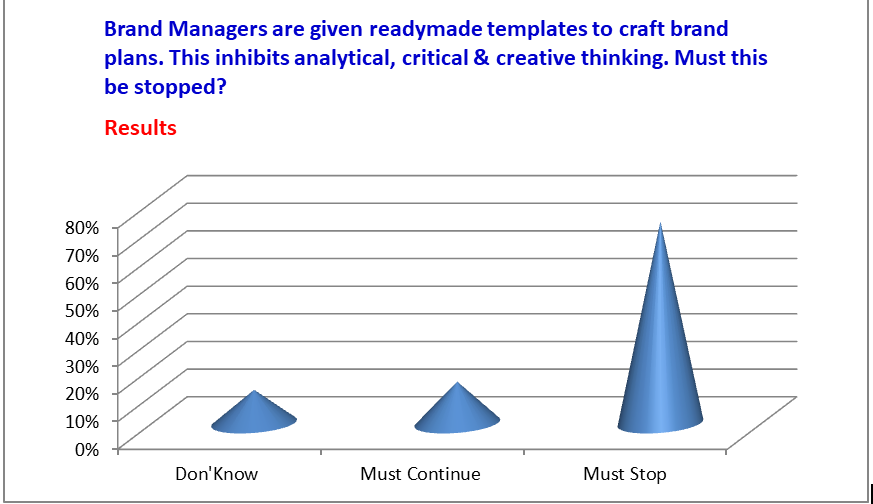Brand Managers or Data Entry Operators? A Wake-Up Call for the Industry – Brand Management 80

Brand Managers or Data Entry Operators: A Wake-Up Call to the Industry
After more than five decades in the world of marketing and brand building, I’ve seen the industry evolve in ways both inspiring and troubling.
Recently, I conducted a poll on LinkedIn that left me deeply uncomfortable. The question was straightforward: “Brand managers are given templates to craft brand plans. This inhibits analytical, critical & creative thinking. Must this be stopped? Results
The results?
- 12% said “Don’t know.”
- 15% said “Must continue.”
- 73% said “Must be stopped.”
Now, 73% might seem like a strong majority. But I was disappointed. I had expected—hoped—for over 95% to say “Must be stopped.” Why? Because this issue strikes at the very heart of what it means to be a brand manager.
Let me share what prompted this poll.
I recently had the opportunity to review brand plan templates from three pharmaceutical companies—Wellbeing Pharma, V & V Pharma, and Distinctive Pharmaceuticals (names changed to protect confidentiality). What I saw was not just disheartening—it was alarming.
Each template was a maze of numbers.
Sales targets. SKU breakdowns.
Zone-wise, region-wise, area-wise, medical representative-wise data.
Excel sheets that demanded inputs but offered no room for thought.
The brand managers were expected to enter figures, project growth, and hit a target—say, Rs. 375 crore by 2026-27.
But nowhere in these templates was there space for strategy. No room for vision.
No invitation to think.
It was all tactic. All timelines. All data.
And that’s the problem.
When we reduce brand planning to filling out spread-sheets, we strip away the very essence of brand management. We turn thinkers into typists. We turn leaders into followers. We turn brand managers into data-entry operators.
This is not just inefficient—it’s dangerous.
Because brands are not built on numbers alone.
They are built on insight.
On imagination.
On the ability to ask “why” and “what if.”
On the courage to challenge assumptions and the creativity to craft new narratives.
When brand managers are given a free hand—when they are trusted to think, to analyze, to dream—something powerful happens.
They begin with a situational analysis, not just to check a box, but to truly understand the brand’s current reality.
They ask, “Why are we here?” They explore what’s working, what’s broken, and what’s changing.
They conduct a meaningful SWOT analysis—not just for their own brand, but for competitors too. Not to mimic, but to differentiate. To find that one bold move that sets them apart.
They embrace zero-based budgeting—not just carrying forward last year’s numbers, but asking, “What do we really need? What can we do differently?”
They craft national strategies with clarity and conviction. And then, they adapt them into local strategies that resonate with real people in real markets.
They stop thinking in linear growth. They start thinking in leaps. They stop waiting for directives from the marketing head. They start leading.
This is the kind of thinking that builds mega brands. This is the kind of mindset that creates exponential growth. This is the kind of leadership our industry needs.
Of course, data has its place. It’s essential. But it’s a tool—not a substitute for thinking. Templates can be helpful too—if they prompt thought, not replace it. But when templates become straightjackets, when they become the plan instead of guiding the plan, we have a problem.
I say all this not as someone who knows it all. Far from it. I am a perpetual learner. Every day, I learn from young brand managers, from new markets, from unexpected insights. That’s the beauty of this profession—it keeps you humble. It keeps you curious.
But I do speak with the weight of experience. And with a heart full of hope.
Hope that we will not let our brand managers become mere number-punchers. Hope that we will nurture thinkers, dreamers, doers. Hope that we will build a generation of leaders who can look beyond the spreadsheet and see the story.
Because if we don’t—if we continue down this path of templated thinking—we risk something far greater than poor brand plans.
We risk a future where our C-suites are filled with leaders who cannot think.
So, to every marketing head, every CEO, every HR leader reading this, I say:
PLEASE DO NOT REDUCE BRAND MANAGERS TO DATA-ENTRY OPERATORS.
Let them think. Let them question. Let them imagine.
And watch them build brands—and futures—you never thought possible.